
Nancy Drew is a fictional character, a sleuth in an American mystery series created by publisher Edward Stratemeyer as the female counterpart to his Hardy Boys series. The character first appeared in 1930. The books are ghostwritten by a number of authors and published under the collective pseudonym Carolyn Keene. Over the decades, the character evolved in response to changes in US culture and tastes. The books were extensively revised and shortened, beginning in 1959, in part to lower printing costs with arguable success. In the revision process, the heroine's original character was changed to be less unruly and violent. In the 1980s, an older and more professional Nancy emerged in a new series, The Nancy Drew Files, that included romantic subplots for the sleuth. The original Nancy Drew Mystery Stories series started in 1930 and ended in 2003. Launched in 2004, the Girl Detective series features Nancy driving a hybrid electric vehicle and using a cell phone. In 2012, the Girl Detective series ended, and a new series, Nancy Drew Diaries, was launched in 2013. Illustrations of the character evolved over time to reflect contemporary styles. The character proves continuously popular worldwide: at least 80 million copies of the books have been sold, and the books have been translated into over 45 languages. Nancy Drew is featured in five films, three television shows, and a number of popular computer games; she also appears in a variety of merchandise sold around the world.

Mildred Augustine Wirt Benson was an American journalist and author of children's books. She wrote some of the earliest Nancy Drew mysteries and created the detective's adventurous personality. Benson wrote under the Stratemeyer Syndicate pen name, Carolyn Keene, from 1929 to 1947 and contributed to 23 of the first 30 Nancy Drew mysteries, which were bestsellers.
The Dana Girls was a series of young adult mystery novels produced by the Stratemeyer Syndicate. The title heroines, Jean and Louise Dana, are teenage sisters and amateur detectives who solve mysteries while at boarding school. The series was created in 1934 in an attempt to capitalize on the popularity of both the Nancy Drew Mystery Stories and the Hardy Boys series, but was less successful than either. The series was written by a number of ghostwriters and, despite going out-of-print twice, lasted from 1934 to 1979; the books have also been translated into a number of other languages. While subject to less critical attention than either Nancy Drew or the Hardy Boys, a number of critics have written about the series, most arguing that the Dana Girls' relative lack of success was due to the more dated nature of the series.

Howard Roger Garis was an American author, best known for a series of books that featured the character of Uncle Wiggily Longears, an engaging elderly rabbit. Many of his books were illustrated by Lansing Campbell. Garis and his wife, Lilian Garis, were possibly the most prolific children's authors of the early 20th century.
Charles Leslie McFarlane was a Canadian journalist, novelist, screenwriter, and filmmaker, who is most famous for ghostwriting many of the early books in the very successful Hardy Boys series, using the pseudonym Franklin W. Dixon.
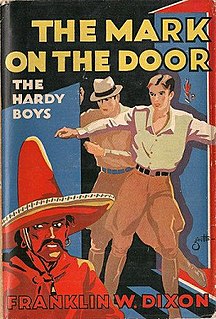
The Mark on the Door is Volume 13 in the original The Hardy Boys Mystery Stories published by Grosset & Dunlap.

The Motor Boys were the heroes of a popular series of adventure books for boys at the turn of the 20th century issued by the Stratemeyer Syndicate under the pseudonym of Clarence Young. This series was published by Cupples & Leon and was issued with dustjackets and glossy frontispiece. Howard Garis wrote many, if not all, of these stories.
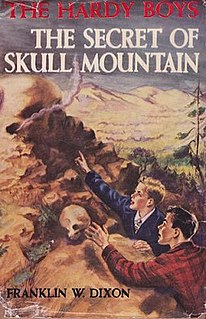
The Secret of Skull Mountain is Volume 27 in the original The Hardy Boys Mystery Stories published by Grosset & Dunlap.

The Wailing Siren Mystery is Volume 30 in the original The Hardy Boys Mystery Stories published by Grosset & Dunlap.
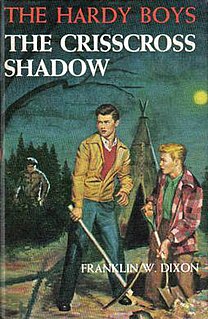
The Crisscross Shadow is Volume 32 in the original The Hardy Boys Mystery Stories published by Grosset & Dunlap.
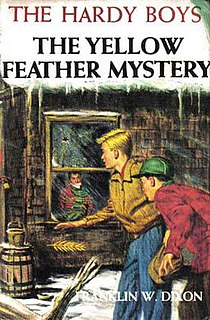
The Yellow Feather Mystery is Volume 33 in the original The Hardy Boys Mystery Stories published by Grosset & Dunlap.

The Clue in the Embers is Volume 35 in the original The Hardy Boys Mystery Stories published by Grosset & Dunlap.
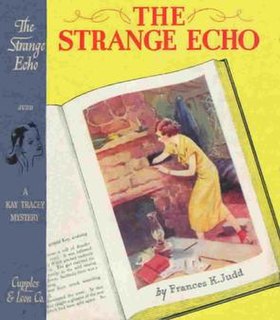
The Kay Tracey Mysteries were published under the name Frances K. Judd, a house pseudonym of the Stratemeyer Syndicate, a book packager. The series was conceived as a response to the popularity of the Nancy Drew Mystery Stories and likewise features a teenage girl detective. While the original entries in the series lasted only from 1934 to 1942, the books were updated, revised, and have been re-issued numerous times, most recently by Bantam Books in the 1980s, and have been translated into Swedish and French. Many critics see Kay Tracey as markedly inferior to Nancy Drew, but some find the series to be significant as one of a number of series that provided girls with a feminist role model prior to third-wave feminism.
The Nancy Drew Mystery Stories is the long-running "main" Nancy Drew series, which was published under the pseudonym Carolyn Keene. There are 175 novels — plus 34 revised stories — that were published between 1930 and 2003 under the banner; Grosset & Dunlap published the first 56, and 34 revised stories, while Simon & Schuster published the series beginning with volume 57.
The Honey Bunch series of books were part of the Stratemeyer Syndicate's production of 20th century children's books featuring adventurous youngsters, which included the series Nancy Drew, the Hardy Boys and the Bobbsey Twins. This series was written under the pseudonym Helen Louise Thorndyke, and published for most of its duration by Grosset & Dunlap. The series began in 1923 and chronicled a young girl named Honey Bunch on her various trips and adventures.
The Ruth Fielding books were an early Stratemeyer Syndicate series, published between 1913 and 1934 under the pseudonym Alice B. Emerson. Ruth Fielding begins the series as an orphan who comes to live with her miserly uncle and, in later titles, goes from boarding school to college and on into adulthood. Unusually, for a main character in a Stratemeyer Syndicate series, Ruth Fielding marries.











